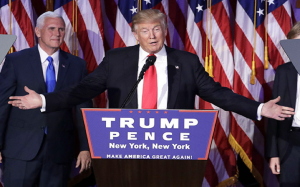How Push Vs. Pull Marketing became to be a deciding factor in the 2016 Presidential Election
On Election Night 2016, the presidential election was decided as President-Elect, Donald Trump, shockingly won the election, totaling 279 electoral votes while his opponent, Hilary Clinton, secured 228 electoral votes. This was a stunning victory for the Republican Candidate, as every major poll had Senator Clinton winning by at least a 3-5-point margin. The pollsters were not the only ones who believed Clinton would win, as even many Republican congressmen believed that Mr. Trump would not win. Mr. Trump secured many traditional blue states such as Pennsylvania Michigan, and Wisconsin which have not voted for a Republican since the 1980s. Trump reached to a blue-collar working white class, who have long been democratic, but frustrated by the way things were in their life had gone. Trump provided the American people with a different voice with his promise to create a better life. By being a Washington outsider, his campaign was un-orthodox, creative a unique persuasive campaign.
A big part of why Trump connected with the blue-collar, white, working-class in these respective states can be attributed to the way he used Pull Marketing to attract voters. The Trump campaign exploded in the primaries due to the remarks he made on Twitter regarding his plan for change in the country, if elected. Many people did not believe he had the capability of winning the Primaries, let alone the election, but he won the Primaries and used his Twitter account to his advantage. During the General Election, he did not allow his staff to edit his tweets before he sent it out to the public (Until three days before the election where his staff took his Twitter account from him*). This was unique, as no one had ever done this before, it was the original, honest thoughts that made Mr. Trump so appealing to voters because he was a political outsider, who did not conform to the traditional “Political Correctness” when speaking in public. Mr. Trump’s opinions resonated with many citizens across the country, as he has 14 million followers on Twitter. He gained 6 million followers since June 2016, which showed that his following continued to grow throughout the general election. I point to this occurrence as being directly related to his techniques of Pull Marketing.

This type of marketing made him more attractive to consumers in this day and age, as they would rather choose on what to be advertised by rather than have the advertisements pushed onto themselves from a traditional media outlet. In traditional media outlets, Mr. Trump was consistently criticized during the general election with the comments he had made on Twitter, past scandals he had been involved in, and his political agenda. This made so many people believe that Senator Clinton had a very strong chance of winning the election. While Senator Clinton also did pursue Pull Marketing in her campaign, it was not as original as Mr. Trump’s, with most of her social media comments being from a campaign worker, not the candidate herself. It seems that Mr. Trump figured out what the next step is for using Digital Marketing going forward in political elections. While President Obama was the first to use Digital Marketing to his advantage in winning an election, it seems that Senator Clinton took the same approach and did not win because of her traditional approach, relying heavily on the traditional media outlets to advertise against Mr. Trump through Push Marketing.
Living in Wisconsin for most of the general election, a majority of political TV advertisements were for Senator Clinton as opposed to Mr. Trump, who rarely used TV advertisements as a part of his campaign. While skeptics thought that that would fail, it appeared to work in his favor. Mr. Trump’s primary use of Pull Marketing appealed to the white working-classes of people in Wisconsin, Michigan and Pennsylvania, putting him over 270 electoral votes needed to win the presidential election. The victory of Mr. Trump has to beg the question if he would have won the election if Bernie Sanders was the Democratic Candidate for President as he had a stronger following on social media similar to Mr. Trump. It has been a hot topic of debate following the night of the election but we will never know the answer. As we have seen during this evolution of Digital Marketing, the effective use of Pull Marketing begs the question of how can advertisements be priced in the future through traditional means and through social media outlets.
Shivam Shah is a Real Estate and Marketing Major at the University of Wisconsin-Madison. You can connect with him at LinkedIn here.






